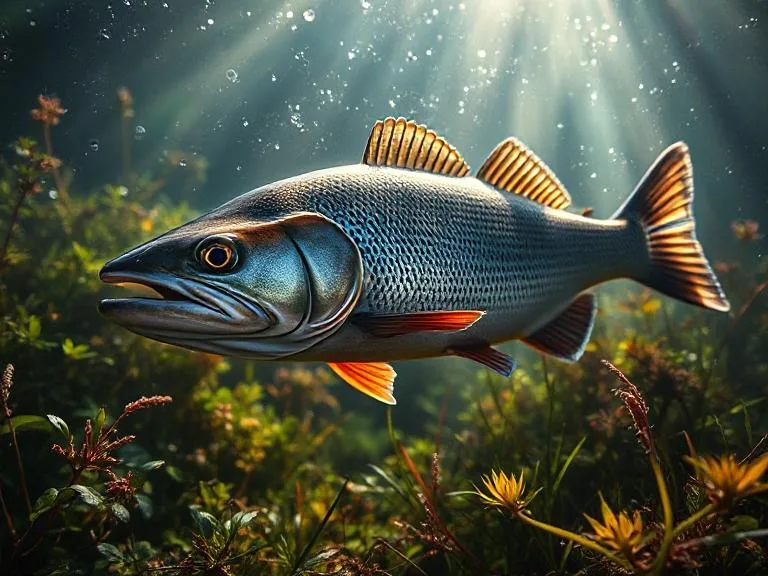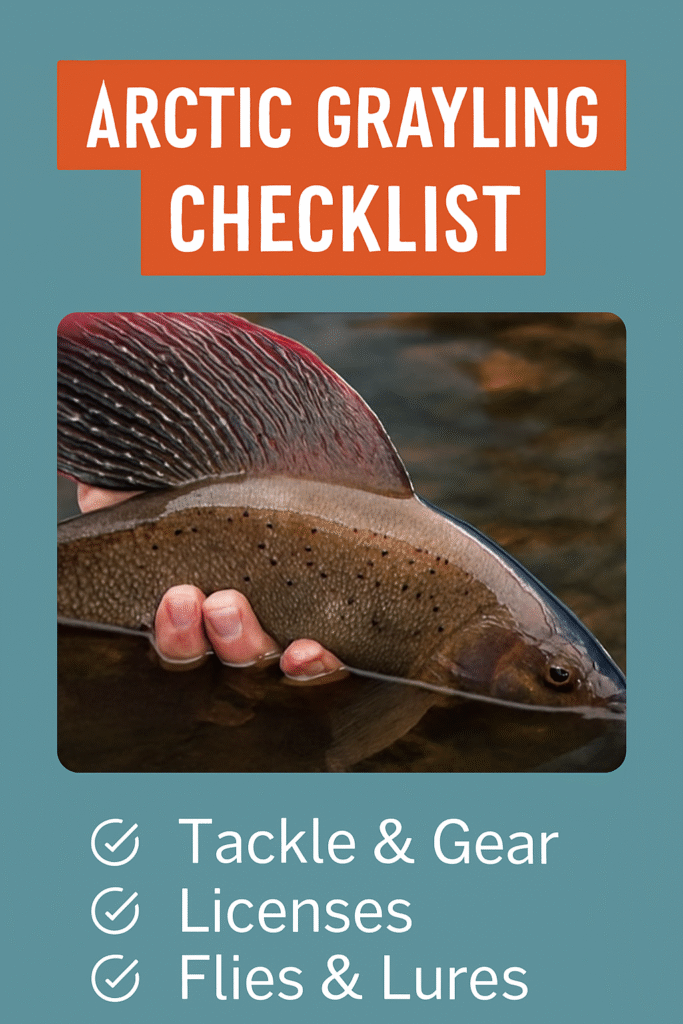Planning your first Arctic Grayling trip in Canada? This checklist covers everything you need — from licenses and regulations to gear, flies, safety, and conservation. Written from firsthand experience in the Yukon, this guide is designed to help you fish smarter, stay compliant, and maximize your chances of landing trophy Grayling.

✅ Why a Checklist Matters – Arctic Grayling

When I planned my first Arctic Grayling trip in the Yukon, I thought I had everything covered. But halfway through the trip, I realized I’d forgotten polarized sunglasses — and I missed countless fish because I couldn’t spot them in the glare. That’s when I started building a comprehensive checklist.
This isn’t just a packing list. It’s a step‑by‑step system that ensures you’re prepared for every stage of your trip: licensing, travel, gear, safety, and conservation.
🗂️ Section 1: Licensing & Regulations – Arctic Grayling
Checklist Items:
- ✅ Non‑Resident Fishing License (if applicable)
- ✅ Conservation stamps (required in some provinces/territories)
- ✅ Printed or digital copy of regulations for your fishing zone
- ✅ Barbless hooks (mandatory in many northern waters)
- ✅ Catch‑and‑release guidelines
👉 Always check Fisheries and Oceans Canada and Yukon Fishing Regulations before your trip.
Why it matters: Nothing kills a trip faster than being out of compliance.
🎣 Section 2: Core Fishing Gear – Arctic Grayling
Fly Fishing Setup:
- ✅ 4–5 weight fly rod (ideal for Grayling)
- ✅ Lightweight reel with smooth drag
- ✅ Floating line with 9‑foot leader
- ✅ Tippet spools (3X–5X)
Spin Fishing Setup:
- ✅ Ultralight rod with 4–6 lb test line
- ✅ Small spinners (Mepps #0–#2)
- ✅ Micro spoons (silver, gold, copper)
- ✅ Jig heads with soft plastics
🪰 Section 3: Flies & Lures – Arctic Grayling
Dry Flies:
- ✅ Elk Hair Caddis
- ✅ Adams
- ✅ Royal Wulff
Nymphs:
- ✅ Beadhead Pheasant Tail
- ✅ Hare’s Ear
Streamers:
- ✅ Small Woolly Buggers
- ✅ Zonkers
Spin Lures:
- ✅ Mepps Aglia (silver/gold)
- ✅ Panther Martin spinners
- ✅ Little Cleo spoons
👉 Pro Tip: Pack duplicates. Grayling is aggressive, and you’ll lose flies to rocks and snags.
🧳 Section 4: Clothing & Wading Gear – Arctic Grayling
- ✅ Breathable chest waders
- ✅ Wading boots with felt or rubber soles
- ✅ Layered clothing (base, mid, outer)
- ✅ Waterproof jacket
- ✅ Polarized sunglasses
- ✅ Wide‑brim hat or cap
Why it matters: Northern Canada weather changes fast. Staying dry and warm keeps you fishing longer.
🧊 Section 5: Safety & Survival
- ✅ Bear spray (mandatory in many northern areas)
- ✅ First aid kit
- ✅ Satellite phone or Garmin InReach
- ✅ Emergency blanket
- ✅ Water purification tablets
- ✅ Headlamp with spare batteries
🛶 Section 6: Travel & Logistics
- ✅ Fly‑in lodge booking confirmation
- ✅ Floatplane weight allowance checked
- ✅ Dry bags for gear
- ✅ Waterproof cases for electronics
- ✅ Extra fuel canisters (if camping)
- ✅ Maps & GPS coordinates
First‑person note: On my first fly‑in trip, I underestimated weight restrictions. I had to leave behind a cooler of food at the dock. Lesson learned: weigh everything in advance.
🧠 Section 7: Conservation & Ethics
- ✅ Barbless hooks only
- ✅ Rubberized landing net
- ✅ Keep fish wet (minimize air exposure)
- ✅ Photograph quickly, release gently
- ✅ Pack out all garbage
📋 Full Arctic Grayling Checklist (Printable)
Here’s the condensed version you can print or save:
- Licenses & Regulations
- Fly/Spin Gear
- Flies & Lures
- Clothing & Wading Gear
- Safety & Survival
- Travel & Logistics
- Conservation & Ethics
FAQ
Q: What is the best time to fish for Arctic Grayling in Canada? A: June–August is prime dry‑fly season, while September offers aggressive pre‑spawn feeding.
Q: Do I need a special license for Arctic Grayling? A: Yes, a provincial/territorial fishing license is required. Non‑residents must purchase a non‑resident license.
Q: What flies work best for Arctic Grayling? A: Elk Hair Caddis, Adams, Royal Wulff, and beadhead nymphs are top producers.
🧠 Most Searched FAQ
1. What is an Arctic Grayling?
The Arctic Grayling (Thymallus arcticus) is a freshwater fish native to northern Canada, Alaska, and parts of Siberia. It’s famous for its large, sail‑like dorsal fin and iridescent colors. Anglers prize it for its beauty and willingness to rise to dry flies.
2. Where can I catch Arctic Grayling in Canada?
Top regions include:
- Yukon: Teslin, Pelly, and Stewart Rivers
- Northwest Territories: Great Slave Lake tributaries
- Nunavut: Remote rivers often combined with Arctic Char trips
- Northern Alberta & Saskatchewan: Accessible Road‑system rivers like the Athabasca
3. What is the best time to fish for Arctic Grayling?
- June–August: Prime dry‑fly season with long daylight hours.
- September: Pre‑spawn feeding frenzy, aggressive takes, and stunning fall colors.
4. What flies work best for Arctic Grayling?
- Dry flies: Elk Hair Caddis, Adams, Royal Wulff
- Nymphs: Beadhead Pheasant Tail, Hare’s Ear
- Streamers: Small Woolly Buggers, Zonkers
5. What lures work best for Arctic Grayling?
For spin anglers:
- Mepps Aglia spinners (#0–#2)
- Panther Martin spinners
- Little Cleo spoons (silver/gold)
6. Do I need a license to fish for Grayling in Canada?
Yes. Every province/territory requires a fishing license. Non‑residents must purchase a non‑resident license and, in some cases, conservation stamps. Always check Fisheries and Oceans Canada and local regulations.
7. How big do Arctic Grayling get?
Most Grayling average 12–16 inches, but trophy fish can exceed 20 inches and weigh over 3 pounds in northern waters like the Yukon and NWT.
8. Are Arctic Grayling good to eat?
Yes, but many anglers practice catch‑and‑release to conserve populations. The flesh is white and mild, but Grayling are more valued as a sportfish than a food source.
9. What habitat do Grayling prefer?
They thrive in cold, clean rivers and lakes with gravel bottoms and steady current. They’re often found in riffles, pools, and near inlets/outlets where insect life is abundant.
10. Are Arctic Grayling endangered?
No, Arctic Grayling are not endangered in Canada, but some southern populations (like in Montana and Michigan) are considered threatened. Conservation practices like barbless hooks and catch‑and‑release help protect them.
Conclusion: Why This Checklist Works
Every time I fish for Arctic Grayling, I refine this list. It’s not just about catching fish — it’s about being prepared for the unique challenges of Canada’s north. With this checklist, you’ll avoid rookie mistakes, stay compliant, and maximize your chances of landing the fish of a lifetime.






















